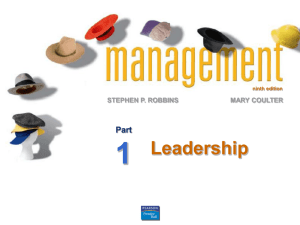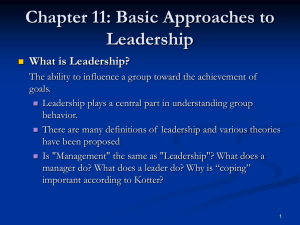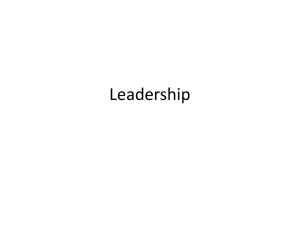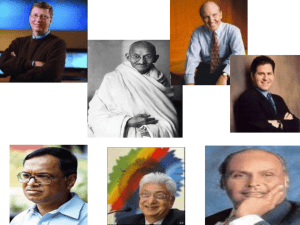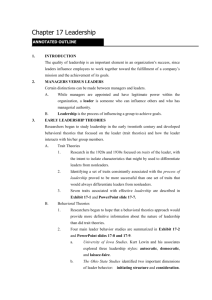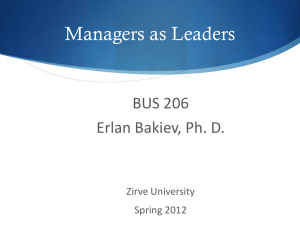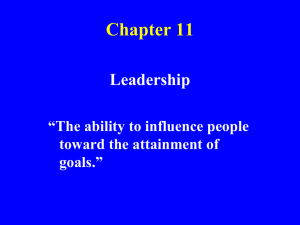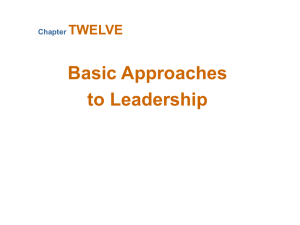here
advertisement
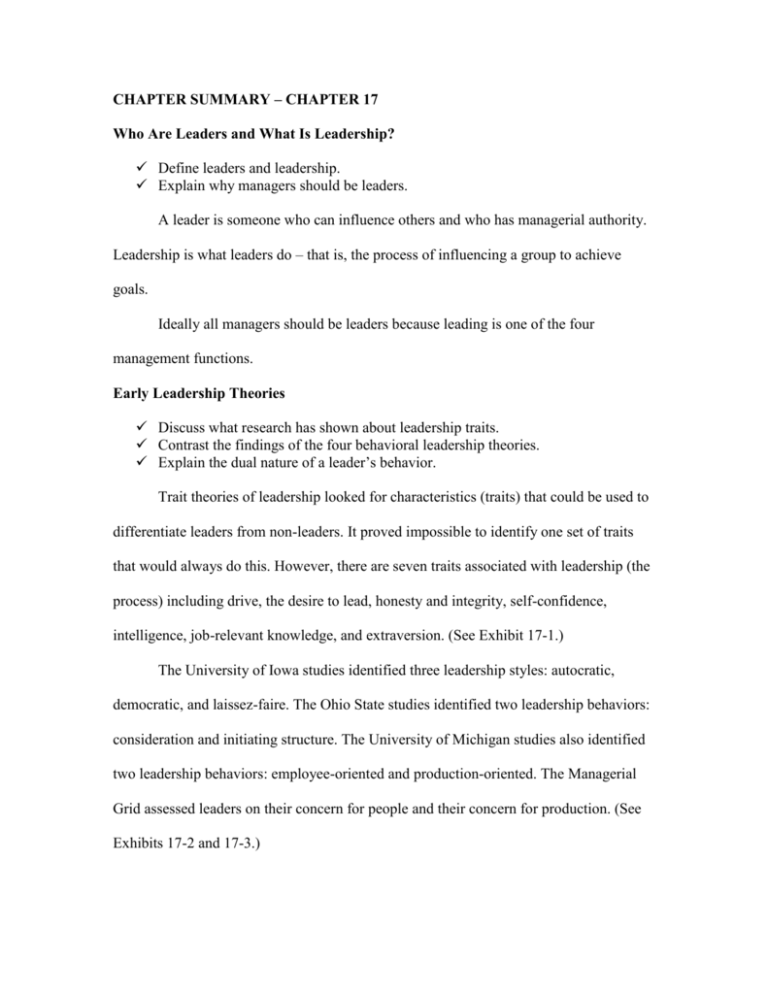
CHAPTER SUMMARY – CHAPTER 17 Who Are Leaders and What Is Leadership? Define leaders and leadership. Explain why managers should be leaders. A leader is someone who can influence others and who has managerial authority. Leadership is what leaders do – that is, the process of influencing a group to achieve goals. Ideally all managers should be leaders because leading is one of the four management functions. Early Leadership Theories Discuss what research has shown about leadership traits. Contrast the findings of the four behavioral leadership theories. Explain the dual nature of a leader’s behavior. Trait theories of leadership looked for characteristics (traits) that could be used to differentiate leaders from non-leaders. It proved impossible to identify one set of traits that would always do this. However, there are seven traits associated with leadership (the process) including drive, the desire to lead, honesty and integrity, self-confidence, intelligence, job-relevant knowledge, and extraversion. (See Exhibit 17-1.) The University of Iowa studies identified three leadership styles: autocratic, democratic, and laissez-faire. The Ohio State studies identified two leadership behaviors: consideration and initiating structure. The University of Michigan studies also identified two leadership behaviors: employee-oriented and production-oriented. The Managerial Grid assessed leaders on their concern for people and their concern for production. (See Exhibits 17-2 and 17-3.) As these behavioral studies showed, a leader’s behavior encompasses two dimensions: people and tasks. Contingency Theories of Leadership Explain how Fiedler’s model of leadership is a contingency model. Contrast situational leadership theory and the leader participation model. Discuss how path-goal theory explains leadership. Fiedler’s contingency model of leadership proposed that effective group performance depended on properly matching the leader’s style of interacting with his or her followers (relationship oriented or task oriented) and the degree to which the situation allowed the leader to control and influence (leader-member relations, task structure, and position power). (See Exhibit 17-4.) Fiedler believed, however, that a leader’s style was fixed. Situational leadership theory is a contingency theory that focuses on followers’ readiness. Successful leadership is achieved by selecting the right leadership style which is contingent on the followers’ readiness level. (See Exhibit 17-5.) The leader participation model related leadership behavior and participation to decision making. It uses a decision-tree approach to determine the best style of leadership. (See Exhibits 17-6 and 17-7.) Path-goal theory states that it’s the leader’s job to assist his or her followers in attaining their goals and to provide the direction or support needed to ensure that their goals are compatible with the overall group’s goals. To do this, leaders choose from four leadership behaviors: directive, supportive, participative, and achievement oriented. (See Exhibit 17-8.) Contemporary Views of Leadership Differentiate between transactional and transformational leaders. Describe charismatic and visionary leadership. Discuss what team leadership involves. Transactional leadership describes how leaders lead primarily by using social exchanges (or transactions). Transformational leadership describes how leaders stimulate and inspire (transform) followers to achieve extraordinary outcomes. Charismatic leadership is a leader whose enthusiastic, self confident personality and actions (charisma) influence people to behave in certain ways. Visionary leadership is the ability to create and articulate a realistic, credible, and attractive vision of the future that improves upon the present situation. Team leadership is leading teams. There are four specific team leadership roles: coach, liaison with external constituencies, troubleshooter, and conflict manager. (See Exhibit 17-9.) Leadership Issues in the Twenty-First Century Tell the five sources of a leader’s power. Discuss the issues today’s leaders face. Explain why leadership is sometimes irrelevant. The five sources of a leader’s power are legitimate (power because of position of authority), coercive (power to punish or control), reward (power to give positive benefits or rewards), expert (power based on expertise, special skills, or knowledge), and referent (power from desirable resources or personal traits). The main issues that leaders face today are developing trust (see Exhibit 17-10), providing ethical leadership, empowering employees, cross-cultural leadership challenges (see Exhibit 17-11), gender differences in leadership (see Exhibit 17-12), and the demise of the “celebrity” leader. Leadership is sometimes irrelevant because certain individual, job, or organizational variables can act as substitutes for leadership.
